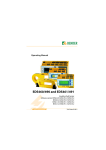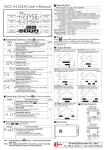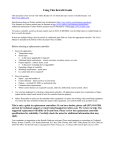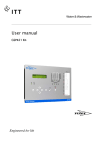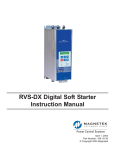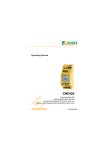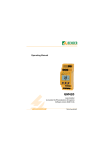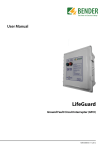Download RCM420-DM RCM420-DM1C RCM420-DM2C RCM420
Transcript
Operating Manual RCM420-DM RCM420-DM1C RCM420-DM2C RCM420-DM3C Residual current monitor for AC current monitoring in TN and TT systems with an analogue interface Software version: D240 v1.1x Power in electrical safety TGH1404en/07.2010 Bender Inc. USA: 700 Fox Chase Coatesville, PA 19320 Toll Free: 800-356-4266 Phone: 610-383-9200 Fax: 610-383-7100 E-mail: [email protected] Canada: 5810 Ambler Drive, Unit 1 Mississauga, ON L4W 4J5 Toll Free: 800-243-2438 Phone: 905-602-9990 Fax: 905-602-9960 E-mail: [email protected] © Bender Inc. Web: http://www.bender.org All rights reserved. Content subject to change. Table of Contents 1. Effective use of this manual ........................................................................... 7 1.1 1.2 1.3 Notes for the user ............................................................................................. 7 Intended use ...................................................................................................... 7 Information about factory setting ............................................................. 8 2. Safety information ........................................................................................... 9 2.1 2.2 Safety instructions ........................................................................................... 9 Work activities on electrical installations ................................................ 9 3. Function ........................................................................................................... 11 3.1 3.2 3.2.1 3.2.2 3.2.3 3.2.4 3.2.5 3.2.6 3.2.7 3.2.8 3.2.9 3.2.10 3.2.11 3.2.12 3.2.13 3.2.14 3.2.15 3.2.16 3.2.17 Device features .............................................................................................. Function ............................................................................................................ Connection monitoring .............................................................................. Additional cascaded measuring current transformer ...................... Fast response value query ......................................................................... Automatic self test ........................................................................................ Manual self test .............................................................................................. Functional faults ............................................................................................ Preset the number of reload cycles ........................................................ Assigning alarm categories to alarm relay K2 ..................................... Time delays t, ton and toff .......................................................................... Starting delay t ............................................................................................... Response delay ton2 ..................................................................................... Delay on release toff ...................................................................................... Residual current monitoring in window discriminator mode ...... Password protection (on, OFF) ................................................................. Factory setting FAC ...................................................................................... Erasable history memory ............................................................................ External, combined test resp. reset button T/R .................................. TGH1404en/07.2010 11 11 12 12 12 12 13 13 13 13 13 14 14 14 14 14 14 15 15 3 Table of Contents 3.2.18 Interface options ........................................................................................... 15 4. Installation and connection ......................................................................... 17 5. Operation and setting .................................................................................. 21 5.1 5.2 5.3 5.3.1 5.3.2 5.4 5.5 5.5.1 5.5.2 5.5.3 5.5.4 5.5.5 5.5.6 5.5.7 5.5.8 5.5.9 5.5.10 5.5.11 5.5.12 5.5.13 5.5.14 5.5.15 5.6 Display elements ........................................................................................... 21 Function of the operating elements ...................................................... 22 Menu structure ............................................................................................... 23 Menu structure of the M1C, M2C, M3C options ................................. 23 Menu structure option M .......................................................................... 25 Display in standard mode .......................................................................... 26 Display in menu mode ................................................................................ 27 Parameter query and setting: Overview ............................................... 27 Changeover from overcurrent to undercurrent operation or to window operation .............................................................................. 29 Response value setting for overcurrent: ............................................... 30 Setting the fault memory and alarm relay operating mode .......... 31 Select output current range of the analogue interface ................... 32 Select output current and output voltage range of the analogue interface ........................................................................................ 32 Assigning alarm categories to the alarm relays ................................. 33 Set 100% value related to the analogue interface ............................ 35 Set the time delays ........................................................................................ 36 Changing from overcurrent operation to window operation ...... 37 Setting the correction factor for an additional cascaded current transformer. ..................................................................................... 37 Factory setting and password protection ............................................ 38 Re-establishing the factory settings ....................................................... 39 Device information query .......................................................................... 39 History memory query ................................................................................. 40 Commissioning and testing ...................................................................... 40 6. Technical data ................................................................................................ 41 6.1 4 Data in tabular form ..................................................................................... 41 TGH1404en/07.2010 Table of Contents 6.2 6.3 6.4 6.5 6.6 5 Standards, approvals and certification .................................................. 44 Ordering information ................................................................................... 44 Timing diagram: Overcurrent monitoring ............................................ 46 Current and voltage curves of the analogue interface .................... 47 Error codes ....................................................................................................... 48 TGH1404en/07.2010 1. Effective use of this manual 1.1 Notes for the user This manual is intended for experts in electrical engineering and electronics! In order to make it easier for you to find specific text passages or references in this manual and for reasons of comprehensibility, important information is emphasized by symbols. The meaning of these symbols is explained below: Information intended to assist the user to make optimum use of the product are marked with the Info symbol. Information calling attention to hazards are marked with this warning symbol. 1.2 Intended use The AC and pulsed DC sensitive residual current monitor RCM420 (Type A) from Bender is designed for fault and residual current monitoring in earthed power supply systems (TN/TT systems) where an alarm is to be activated in the event of a fault, but disconnection must be prevented. In addition, the device can be used to monitor single conductors, such as PE conductors, N-PE connections and PE-PAS connections. Two separately adjustable response ranges IΔn1 and IΔn2 allow to distinguish between prewarning and alarm (IΔn1 = 50…100 % of the set response value IΔn2). TGH1404en/07.2010 7 Effective use of this manual 1.3 Information about factory setting Seite 40 provides a summary of all factory settings. If you want to reset the residual current monitor to factory settings, refer to Seite 39. 8 TGH1404en/07.2010 2. Safety information 2.1 Safety instructions In addition to this data sheet, the documentation of the device includes a sheet entitled "Important safety instructions for BENDER products“. 2.2 Work activities on electrical installations All work activities necessary for installation, commissioning or work activities during operation of electrical devices or systems are to be carried out by adequately skilled personnel. Observe the relevant regulations applying to work on electrical installations, in particular DIN EN 50110 or its subsequent regulation. Unprofessional work activities on electrical installations may result in a threat of danger to life and limb! If the equipment is used outside the Federal Republic of Germany, the respective national standards and regulations are to be observed. The European standard EN 50110 is recommended to be used as a directive. TGH1404en/07.2010 9 Safety information 10 TGH1404en/07.2010 3. Function 3.1 Device features AC and pulsed DC sensitive residual current monitor Type A according to IEC 62020 Analogue interface configurable acc. to response value or configurable Adjustable switching hysteresis r.m.s. value measurement Starting delay, response delay and delay on release Measured value display via multi-functional LC display Alarm indication via LEDs (AL1, AL2) and one changeover contact N/C operation or N/O operation selectable Password protection against unauthorized parameter changing Fault memory behaviour selectable CT connection monitoring 3.2 Function Once the supply voltage Us is applied, the starting delay "t" is activated. Measured values exceeded during this time do not influence the switching state of the alarm relays. Residual current monitoring takes place via an external measuring current transformer. The currently measured value is shown on the LC display. In this way any changes can be recognized easily, for example, when circuits are connected to the system. If the measured value exceeds one or both response values, the response delay ton1/2 starts running. After the expiry of the response delay ton1/2, the selected alarm relay switches and the alarm LEDs light. In addition, an analogue alarm is output for further processing, for example, a current of 0...20 mA. If the release value is not reached before the response delay ton has elapsed, no alarm will be signalled: the LEDs AL1, AL2 do not light and the alarm relay does not switch. The set release time toff begins when the measured value again falls below the release value (reTGH1404en/07.2010 11 Function sponse value minus hysteresis) after the switching of the alarm relays. When the delay time "toff" has elapsed, the alarm relays switch back to their initial position. With the fault memory activated, the alarm relays do not change their actual state until the reset button R is pressed. The device function can be tested using the test button T. The parameterization of the device can be carried out via the LC display and the function keys integrated in the front plate and can be password-protected. 3.2.1 Connection monitoring The CT connections are continuously monitored. In the event of a fault, the alarm relays K1 / K2 switch, the alarm LEDs AL1 / AL2 / ON flash (Error Code E.01). After eliminating the fault, the alarm relays automatically return to their initial position, provided that the fault memory M is deactivated. With the fault memory activated, K1/K2 return to their initial position by pressing the reset button R. A second cascaded measuring current transformer will not be monitored. 3.2.2 Additional cascaded measuring current transformer For applications where residual currents higher than 10 A occur, a second external transformer can be cascaded. The transformer's transmission ratio can be adapted using the correction factor nRCM in the SEt menu. Refer to Seite 20 and Seite 37. 3.2.3 Fast response value query With the display in standard mode, the currently measured response values IΔn1 and IΔn2 can be queried pressing the Up and Down keys ( < 1.5 s). Switchover to the Menu mode is not required. If you want to exit the fast response value query, press the enter key. 3.2.4 Automatic self test The device automatically carries out a self test after connecting to the system to be monitored and later every 24 hours. During the self test internal functional faults will be detected and appear in form of an error code on the display. The alarm relays are not checked during this test. 12 TGH1404en/07.2010 Function 3.2.5 Manual self test After pressing the test button for > 1.5 s, the device carries out a self test. During this test, internal functional faults are detected and will be displayed in form of an error code. The alarm relays are switched during the self test. While the test button T is pressed and held down, all device-related display elements appear on the display. 3.2.6 Functional faults If an internal functional fault occurs, all three LEDs flash. An error code will appear on the display (E01...E32). For example, E08 means: Incorrect internal calibration. In such a case please contact the Bender Service. 3.2.7 Preset the number of reload cycles If a fault occurred in the system being monitored and the system would be disconnected by the alarm relays, the alarm relays would switch on and off, provided that the fault memory M is deactivated. RL in the out menu can be used to limit the number of these changeover processes. As soon as the preset number of switching cycles is exceeded, the fault memory will come on and an activated alarm remains stored. 3.2.8 Assigning alarm categories to alarm relay K2 The alarm categories device error, residual current IΔn1, residual current IΔn2 or alarm by device test can be assigned to the alarm relay via the "out" menu. 3.2.9 Time delays t, ton and toff The times t, ton and toff, described below, delay the output of alarms via LEDs and relays. TGH1404en/07.2010 13 Function 3.2.10 Starting delay t After connection to the supply voltage US, the alarm indication is delayed by the preset time t (0...10 s). 3.2.11 Response delay ton2 If the response value is exceeded or not reached, the residual current monitor requires the response time tan until an alarm is signalled. A preset response delay ton2 (0...10 s) adds up to the device-related operating time tae and delays alarm signalling (total delay time tan = tae + ton). If the residual current fault changes from a value above the response value to a value below the response value before the response delay has elapsed, an alarm will not be signalled. 3.2.12 Delay on release toff When the alarm no longer exists and the fault memory is deactivated, the alarm LEDs go out and the alarm relays switch back to their initial position. When the delay on release (0...99 s) has been preset, the alarm state is continuously maintained for the selected period. 3.2.13 Residual current monitoring in window discriminator mode Change the measuring principle by selecting the window mode .(SEt / In). In the window discriminator mode, the threshold values I1 and I2 represent the upper and the lower value. If the measured value is not within this area, an alarm is initiated by the device. See Seite 37. 3.2.14 Password protection (on, OFF) When password protection is activated (on), settings can only be carried after entering the password (0...999). 3.2.15 Factory setting FAC After activating the factory setting, all settings previously changed are reset to delivery status. 14 TGH1404en/07.2010 Function 3.2.16 Erasable history memory The first alarm value that occurs will be saved in this memory. The memory can be cleared via the menu HiS. 3.2.17 External, combined test resp. reset button T/R Reset = Pressing the external button < 1.5 s Test = Pressing the external button > 1.5 s 3.2.18 Interface options The device provides the following options: M, M1C, M2C or M3C. Option M This option provides an analogue interface with galvanic isolation. One of three output signals can be selected from the associated menu. Only use the output you have selected via the software: – DC 0...400 µA Current output for BENDER measuring instruments of the 96.. series. – DC 0/4...20 mA Standardized current output with selectable current ranges. – DC 0...10 V Standardized voltage signal. The following interface options include the changeover contact K2 to signal an additionally occurring alarm. Option M1C This option provides an analogue interface without galvanic isolation: – DC 0/4...20 mA Standardized current output with selectable current ranges. TGH1404en/07.2010 15 Function Option M2C This option provides an analogue interface without galvanic isolation: – DC 0...400 µA Current output for BENDER measuring instruments of the 96.. series. Option M3C This option provides an analogue interface without galvanic isolation: – DC 0...10 V Standardized voltage signal. 16 TGH1404en/07.2010 4. Installation and connection Ensure safe isolation from supply in the installation area. Observe the installation rules for live working. General dimension diagram and drawing for screw fixing ,5 ,1 36 mm 45 67,5 90 mm 31 Zubehör/ Accessory 116 mm ,5 47 100 mm 70 The front plate cover is easy to open at the lower part marked by an arrow. TGH1404en/07.2010 17 Installation and connection 1. DIN rail mounting: Snap the rear mounting clip of the device into place in such a way that a safe and tight fit is ensured. Screw fixing: Use a tool to move the rear mounting clips (a second mounting clip required, see ordering information) to a position that it projects beyond the enclosure. Then fix the device using two M4 screws. 2. Wiring Connect the device according the wiring diagram. Load T/R A1 A2 k l Optionen Options When connecting the device, it is important to consider the respective device variant (interface option). 18 TGH1404en/07.2010 Installation and connection Terminal Connections A1, A2 Connection to supply voltage Us k, l Connection of measuring current transformers T/R Connection to the combined test and reset button 21, 22, 24 Alarm relay K2 (common) positive pole of the analogue interface, M+, Mnegative pole of the analogue interface µA Current output 0...400 µA mA Current output 0/4...20 mA V Voltage output 0...10 V 21 22 24 M+ T/R A mA V TGH1404en/07.2010 T/R M+ M- 19 Installation and connection Connection of an additional cascaded measuring current transformer If the residual current range of 16 A is not sufficient, an additional measuring current transformer can be cascaded. Connect the measuring current transformer as illustrated in the drawing below. nRCM = X1 X2 RCM420 X2 X1 (x A/10 A) (x A/5 A) (x A/1 A) BENDER W..., WR..., WS... Load Example: An additionally cascaded transformer on the load side has a transmission ratio of X1 = 100 (500 A / 5 A). That means, when the lowest value of 10 mA is set at the RCM420, a current of 1 A can only just be detected on the primary side of the transformer on the load side. In order to reduce the value that can be detected to 100 mA, 10 turns of the supply cable has to be routed through the transformer on the RCM side. Hence, the correction factor to be set is nRCM = X1/X2 = 100/10 = 10. The correction factor can be set via the SEt/n menu. Refer to Seite 37. The correction factor is factory set to 1 and relates to normal operation with one BENDER measuring current transformer only (X = 600:1). 20 TGH1404en/07.2010 5. Operation and setting 5.1 Display elements A detailed description of the meaning of the display elements is given in the table below. Display elements Eleme nt Function RL Reload function with memory = off (L = I.) n Setting the correction factor for an additional cascaded current transformer. I2 Response value IΔn2 as mA (Alarm 2) I1 Response value IΔn1 as % of IΔn2 (Alarm 1, prewarning) r2, 2 Alarm relay K2 I Hys, % Response value hysteresis as % ton2, t, toff Response delay ton2 (K2) Starting delay t, Delay on release toff for K2 M Fault memory active Relay operating mode K2 Password protection enabled TGH1404en/07.2010 21 Operation and setting 5.2 Function of the operating elements Device front Elemen t Function ON, lights continuously: Power On LED green flashes: System fault or connection monitoring fault AL1, AL2 LED Alarm 1 lights( yellow): Response value 1 reached (IΔn1) LED Alarm 2 lights (yellow): Response value 2 reached (IΔn2) 10 mA 10 mA flow through ON T AL1 AL2 R MENU M the current transformer, fault memory active T, Test button (> 1.5 s): To view the available display elements, to start a self test; Up key (< 1.5 s): Menu items/values R, Reset button (> 1.5 s): Deleting the fault memory; Down key (< 1.5 s): Menu items/values MENU, MENU key (> 1.5 s): Starting the menu mode; Enter key (< 1.5 s): Confirm menu item, submenu item and value. Enter key (> 1.5 s): Back to the next higher menu level. 22 TGH1404en/07.2010 Operation and setting 5.3 Menu structure All adjustable parameters are listed in the columns "menu item" and "adjustable parameters". A display-like representation is used to illustrate the parameters in the column menu item. 5.3.1 Menu structure of the M1C, M2C, M3C options Different alarm categories can be assigned to the alarm relays K2 via the submenu r2. This is done by activation or deactivation of the respective function. Sub Menu Menu Menu Activati item on > I2 - (HI) IΔn2 (Alarm 2) > I1 - (HI) IΔn1 as % of IΔn2 (Alarm 1, prewarning) Hys - Hysteresis IΔn1 / IΔn2 - Fault memory AL (response values) M 2 out r2 (output con- (K2: (assigntrol) ment alarm category) AnA Analogue outp.: 100% reference value TGH1404en/07.2010 Adjustable parameter - Operating mode K2 (n.c.) RL - Reload function (memory = off ) I - Option M1C only: 0...20 or 4...20 mA, selectable 2 Err ON Device error at K2 r2 I1 off Prewarning I1 at K2 r2 I2 ON Alarm I2 at K2 2 tES ON Device test I2 AL I - 100 % value related to response value I2 (Alarm 2) - 100 % value related to the user-defined current value 23 Operation and setting Menu Sub Menu Menu Activati item on t t on 2 - Response delay K2 (timing check) t - Starting delay t off - Delay on release K2 I 12 HI Selectable parameters: High, window function, low n 1 Setting the correction factor for an additional cascaded current transformer. off Parameter setting via password Set (device control) FAC - Re-establish factory settings SYS - Function blocked - Display hard / software version - History memory for the first alarm value, erasable InF HiS 24 Adjustable parameter Clr TGH1404en/07.2010 Operation and setting 5.3.2 Menu structure option M Sub Menu Menu Menu Activati item on > I2 - (Hi) IΔn2 (Alarm 2) > I1 - (Hi) IΔn1 as % of IΔn2 (Alarm 1, prewarning) AL (response values) out (output control) AnA Analogue outp.: 100% reference value Adjustable parameter Hys - Hysteresis IΔn1 / IΔn2 M - Fault memory I, U - Selection current / voltage 0...20 or 4...20 mA - 100 % value related to response value I2 (Alarm 2) I - 100 % value related to the user-defined current value I t - Starting delay I 12 HI Selectable parameters: High, window function, low n 1 Transformation ratio factor external current transformer off Parameter setting via password I2 AL t (timing check) Set (device control) InF TGH1404en/07.2010 FAC - Re-establish factory settings SYS - Function blocked - Display hard / software version 25 Operation and setting Menu HiS Sub Menu Menu Activati item on Clr - Adjustable parameter History memory for the first alarm value, erasable 5.4 Display in standard mode By default, the currently measured residual current is displayed. The current response values I1 (prewarning) and I2 (alarm) can be displayed using the Up and Down key. Press the enter key to return to the measured value. In the standard mode, the currently set response values I1 and I2 can be displayed using the Up and Down keys. 26 TGH1404en/07.2010 Operation and setting 5.5 Display in menu mode 5.5.1 Parameter query and setting: Overview Adjustable parameter Menu item AL out t SEt InF HiS ESC Response values query and setting: – Residual current IΔn2 (AL2) – Residual current IΔn1 (AL1) – Hysteresis of the response values: % Hys Configuration of the fault memory and the alarm relays: – Activating/deactivating the fault memory – Select N/O operation (n.o.) or N/C operation (n.c.) for K2 (does not apply to option M) – Specify the number of the reload cycles – Select output signal (does not apply to Op. M2C, M3C) – Assign the alarm category IΔn1or IΔn2 , relay test or device error to K2 (2, r2) (does not apply to option M) – Select 100% value related to the output signal (AnA) Set delays: – Response delay ton2 (does not apply to option M) – Starting delay t – Delay on release toff (LED, relay) (does not apply to option M) Device control parameter setting: – Select the appropriate parameter for response values: overcurrent (HI), undercurr. (Lo) or window function (In). – Set the correction factor (n) for the 2nd measuring current transformer – Enable or disable password protection, change the password – Re-establish factory settings – Service menu SyS blocked Query hard and software version Query the first stored alarm value Move to the next higher menu level (back) TGH1404en/07.2010 27 Operation and setting Menu structure t >1,5 s t > 1,5 s t < 1,5 s AL out t SEt InF HiS ESC t < 1,5 s t > 1,5 s ESC 28 TGH1404en/07.2010 Operation and setting Parameter settings An example is given here on how to change the alarm response value I1 (IΔn1). It is presumed that the option overcurrent (HI) has been selected in the SEt/I12 menu (factory setting). Proceed as follows: 1. Press the MENU/Enter key for more than 1.5 seconds. The flashing short symbol AL appears on the display. 2. Confirm with Enter. The parameter response value > I2 flashes, in addition the associated overcurrent value > 30 mA appears. 3. Use the Down key to select the parameter response value I1. The parameter I1 flashes, in addition the associated percentage value for prewarning 50 % of I2 appears. 4. Confirm with Enter. The current value for prewarning appears on the flashing display. 5. Use the Up or Down key to set the appropriate response value. Confirm with Enter. I1 flashes. 6. You can exit the menu by: – Pressing the Enter key for more than 1.5 seconds to reach the next higher level or – selecting the menu item ESC and confirming with Enter to reach the next higher level. The currently active segments are flashing! In the figures below, the segments where device settings can be carried out are highlighted by an oval. The menu mode can be reached by pressing the MENU key for more than 1.5 seconds. 5.5.2 Changeover from overcurrent to undercurrent operation or to window operation The operating mode can be set in the SEt/I12 menu using the parameters HI, Lo and In. By default, overcurrent operation (HI) is set. Refer to Seite 37 for a detailed description on how to change over to window operation. TGH1404en/07.2010 29 Operation and setting 5.5.3 Response value setting for overcurrent: - Response value I2 (overcurrent) - Response value I1 (overcurrent) - Hysteresis (Hys) of the response values I1, I2 Increasing the response value I2 (Example: overcurrent) Increasing the response value I1 (prewarning overcurrent) 1x Setting the hysteresis of the response value 2x 30 TGH1404en/07.2010 Operation and setting 5.5.4 Setting the fault memory and alarm relay operating mode Deactivating the fault memory Setting the alarm relay K2 to N/O operation (n.o.) Applies to option M1C, M2C, M3C 1x Setting the number of reload cycles 2x 2x >1,5 s TGH1404en/07.2010 31 Operation and setting 5.5.5 Select output current range of the analogue interface Applies to option M and M1C 3x 2x >1,5 s 0.20 mA means 0...20 mA 4.20 mA means 4...20 mA 5.5.6 Select output current and output voltage range of the analogue interface Applies to option M only. 2x >1,5 s 32 TGH1404en/07.2010 Operation and setting 5.5.7 Assigning alarm categories to the alarm relays Applies to option M1C, M2C, M3C only. Overcurrent, undercurrent and device-related errors of the residual current monitor can be assigned to the alarm relay K1 K2 (r2, 2). By default, the alarm relay K2 signals in case of overcurrent and device-related errors. Alarm relay K2: Deactivating the category device error 4x 3x >1,5 s Alarm relay K2: Activating the category response value I1 4x 1x 3x >1,5 s TGH1404en/07.2010 33 Operation and setting Alarm relay K2: Deactivating the category response value I2 4x 2x 3x >1,5 s Alarm relay K2: Deactivating the category device test 4x 3x 3x >1,5 s When the alarm relay K2 has been deactivated in the menu, an alarm will not be signalled by the respective changeover contact! An alarm will only be indicated by the respective alarm LED (AL1/AL2)! 34 TGH1404en/07.2010 Operation and setting 5.5.8 Set 100% value related to the analogue interface Set here whether the 100% value of the output signal is to be referred to response value I2 (IΔn2) (AL) or to a freely configurable value. Select the appropriate value from the range 10 mA...10 A. Factory setting = related to the response value I2 (IΔn2) (AL). The example below shows how to change the 100% reference of AL = related to the response value to a 100% value of 60 mA. 5x 3x >1,5 s TGH1404en/07.2010 35 Operation and setting 5.5.9 Set the time delays The following delays can be set: Response delay ton2 (0...10 s) for K2 Starting delay t (0...10 s) when the device is being started Delay on release toff (0...99 s) for K2. The setting toff is only relevant when the fault memory M is deactivated. The operating steps for the setting of the response delay ton2 and the starting delay t are illustrated by way of example. Set the response delay ton2 Set the starting delay t 2x >1,5 s 36 TGH1404en/07.2010 Operation and setting 5.5.10 Changing from overcurrent operation to window operation Use this menu item to set whether the response values of the device apply to overcurrent (HI) or undercurrent operation (Lo). In addition, window operation (In) can be selected. 2x >1,5 s 5.5.11 Setting the correction factor for an additional cascaded current transformer. 1x 2x >1,5 s Factory setting without cascaded transformer: n = 1. TGH1404en/07.2010 37 Operation and setting 5.5.12 Factory setting and password protection Use this menu to activate the password protection, to change the password or to deactivate the password protection. In addition, you can use this menu to reset the device to its factory settings. a) Activating the password protection 2x 2x >1,5 s b) Changing the password 2x 2x >1,5 s 38 TGH1404en/07.2010 Operation and setting c) Deactivating the password protection 2x 2x >1,5 s 5.5.13 Re-establishing the factory settings 3x .... 5.5.14 Device information query This function is used to query the software (1.xx) version. After activating this function, data will be displayed as a scrolling text. Once one pass is completed you can select individual data sections using the Up/ Down keys. .... TGH1404en/07.2010 .... 39 Operation and setting 5.5.15 History memory query The history memory can be selected via the menu HiS. Use the Up and Down keys to view the next display. If Clr is flashing, the history memory can be cleared by pressing the Enter key. 5.6 Commissioning and testing Prior to commissioning, check proper connection of the residual current monitor. Factory setting Response value IΔn2 : Response value IΔn1 : Hysteresis: Fault memory M: Operating principle K2 (Err, IΔn2, tES): RL (Reload function): 100% value related to the analogue interface: Response delay K2: Starting delay: Delay on release K2: Transformer correction factor n (nRCM) Password query: 40 30 mA (I2) 50 % (I1) 15 % activated N/C operation (n.c.) 0 Response value I2 ton2 = 0 s t = 0.5 s toff = 1.0 s 1 0, Off TGH1404en/07.2010 6. Technical data 6.1 Data in tabular form ( )* = factory setting Insulation coordination acc. to IEC 60664-1/IEC 60664-3 Rated insulation voltage ....................................................................................................................................... 250 V Rated impulse voltage/pollution degree ........................................................................................................... 4 kV / III Protective separation (reinforced insulation) between:........................................ (A1, A2) - (k/l, T/R) - (21, 22, 24) Voltage test according to IEC 61010-1 ............................................................................................................... 2.21 kV Supply voltage RCM420-D...-1: Supply voltage Us ............................................................................................................... AC 16...72 V / DC 9.6...94 V Frequency range Us ...................................................................................................................................... 42...460 Hz RCM420-D...-2: Supply voltage Us ............................................................................................................................... AC/DC 70...300 V Frequency range Us ...................................................................................................................................... 42...460 Hz Power consumption ............................................................................................................................................. ≤3 VA Measuring circuit External measuring current transformer type..................................................................................... W..., WR..., WS... Load......................................................................................................................................................................... 68 Ω Rated insulation voltage (measuring current transformer) ................................................................................. 800 V Operating characteristic acc. to IEC 62020............................................................................................................ type A Frequency range ........................................................................................................................................ 42...2000 Hz Measuring range ......................................................................................................................................... 3 mA...16 A Relative uncertainty....................................................................................................................................... 0 ... -20 % Operating uncertainty ...................................................................................................................................... 0...-30% Response values Rated residual operating current IΔn1 (prewarning, AL1).............................................. 50...100 % x IΔn2, (50 %)* Rated residual operating current IΔn2 (Alarm, AL2) .............................................................. 10 mA...10 A (30 mA)* Hysteresis ......................................................................................................................................... 10...25 % (15%)* TGH1404en/07.2010 41 Technical data Specified time Starting delay t ...................................................................................................................................... 0...10 s (0.5 s)* Response delay ton2 (Alarm) ................................................................................................................... 0...10 s (0 s)* Delay on release toff.................................................................................................................................. 0...99 s (1 s)* Operating time tae at IΔn = 1 x IΔn1/2 .......................................................................................................... ≤ 180 ms Operating time tae at IΔn = 5 x IΔn1/2 ............................................................................................................ ≤ 30 ms Response time tan .............................................................................................................................. tan = tae + ton1/2 Recovery time tb ............................................................................................................................................. ≤ 300 ms Number of reload cycles .............................................................................................................................. 0...100 (0)* Cable lengths for measuring current transformers Single wire ≥ 0.75 mm2 ..................................................................................................................................... 0...1 m Single wire, twisted ≥ 0.75 mm2 ..................................................................................................................... 0...10 m Shielded cable ≥ 0.75 mm2 ............................................................................................................................. 0...40 m Recommended cable (shielded, shield on one side connected to terminal l of the RCM420, not conn. to earth) ...... J-Y(St)Y min. 2 x 0.8 Connection ..............................................................................................................................................screw terminals Displays, memory Display range, measured value ................................................................................................................... 3 mA...16 A Error of indication .............................................................................................................................± 15 % / ± 2 digit Measured-value memory for alarm value ...................................................................... data record measured values Password ......................................................................................................................................... off / 0...999 (OFF)* Fault memory alarm relay ......................................................................................................................... on / off (off)* Inputs/outputs Cable length for external test / reset button................................................................................................... 0…10 m Voltage output: No-load voltage (terminals open) ................................................................................................................. ≤ DC 20 V Voltage output .............................................................................................................................................. DC 0...10 V Load ................................................................................................................................................................... ≥ 1 KΩ Current outputs: Short-circuit current ......................................................................................................... ≤ 30 mA, short-circuit proof Current output ....................................................................................................................................... DC 0/4...20 mA Load ................................................................................................................................................................ ≤ 500 Ω Current output .......................................................................................................................................... DC 0...400 μA 42 TGH1404en/07.2010 Technical data Load ............................................................................................................................................................. ≤ 12,5 kΩ Switching elements Number of switching elements ............................................................................................. 2 x 1 changeover contact Operating principle ..................................................... N/C operation n.c. / N/O operation n.o. (N/C operation n.c.)* Electrical service life under rated operating conditions.................................................... 10000 switching operations Contact data acc. to IEC 60947-5-1: Utilization category......................................................................AC-13 ......AC-14....... DC-12 ....... DC-12....... DC-12 Rated operational voltage ............................................................230V ...... 230V .......... 24V ........ 110V ........ 220 V Rated operational current.................................................................5 A ...........3 A............ 1 A ......... 0.2 A......... 0.1 A Minimum contact load ......................................................................................... 1 mA at AC / DC ≥ 10 V Environment/EMC EMC ................................................................................................................................................................. IEC 62020 Operating temperature ......................................................................................................................... -25 ºC...+55 ºC Classification of climatic conditions acc. to IEC 60721: Stationary use (IEC 60721-3-3) ........................................................3K5 (except condensation and formation of ice) Transportation (IEC 60721-3-2) ........................................................2K3 (except condensation and formation of ice) Storage (IEC 60721-3-1) ...................................................................1K4 (except condensation and formation of ice) Classification of mechanical conditions acc. to IEC 60721: Stationary use (IEC 60721-3-3) .............................................................................................................................. 3M4 Transportation (IEC 60721-3-2) .............................................................................................................................. 2M2 Storage (IEC 60721-3-1) ......................................................................................................................................... 1M3 Connection Connection..............................................................................................................................................screw terminals Connection properties: rigid/ flexible/ conductor sizes .......................................................................... 0.2...4 / 0.2...2.5 mm2 / AWG 24...12 Multi-conductor connection (2 conductors with the same cross section): rigid/ flexible .................................................................................................................. 0.2...1.5 mm2 / 0.2...1.5 mm2 Stripping length ............................................................................................................................................... 8...9 mm Tightening torque....................................................................................................................................... 0.5...0.6 Nm Other Operating mode ........................................................................................................................... continuous operation Mounting .................................................................................................................................................... any position Protection class, internal components (DIN EN 60529) ...........................................................................................IP30 TGH1404en/07.2010 43 Technical data Degree of protection, terminals (DIN EN 60529).................................................................................................... IP20 Enclosure material..................................................................................................................................... polycarbonate Flammability class.............................................................................................................................................UL94 V-0 DIN rail mounting acc. to................................................................................................................................. IEC 60715 Screw fixing ......................................................................................................................... 2 x M4 with mounting clip Software version .......................................................................................................................................... D240 V1.1x Weight ............................................................................................................................................................... ≤ 160 g ( )* = factory setting 6.2 Standards, approvals and certification 6.3 Ordering information RCM420-D...-1 RCM420-D...-2 Response range IΔn 10 mA...10 A 10 mA...10 A Rated frequency 42...2000 Hz 42...2000 Hz Measuring current transformers W..., WR..., WS... series W..., WR..., WS... series Supply voltage Us* DC 9.6 V...94 V / AC 42...460 Hz, 16...72 V DC 70...300 V / AC 42...460 Hz, 70...300 V B 9401 4005 B 9401 4007 B 9401 4008 B 9401 4009 B 9401 4010 B 9401 4012 B 9401 4013 B 9401 4014 Art. No. : - Option M - Option M1C - Option M2C - Option M3C *Absolute values of the voltage range 44 TGH1404en/07.2010 Technical data External measuring current transformers Type Inside diameter (mm) Art. No. W20 20 B 9808 0003 W35 35 B 9808 0010 W60 60 B 9808 0018 W120 120 B 9808 0028 W210 210 B 9808 0034 WR70x175 70 x 175 B 9808 0609 WR115x305 115 x 305 B 9808 0610 WS50x80 50 x 80 B 9808 0603 WS80x120 80 x 120 B 9808 0606 RCM420 accessories Mounting clip for screw fixing (1 piece per device) ................................................................................. B 9806 0008 Measuring current transformers accessories Snap-on mounting for DIN rail: W20... /W35... .......................................................................................B 9808 0501 Snap-on mounting for DIN rail: W60 .........................................................................................................B 9808 0502 TGH1404en/07.2010 45 Technical data 6.4 Timing diagram: Overcurrent monitoring Overcurrent Start t tan Dt < tan toff Dt Current tan >I Hys Hys <I Supply voltage Alarm LEDs US ON AL1 AL2 Alarm relay N/O operation MEM off Alarm relay N/C operation MEM off Alarm relay N/O operation MEM on Alarm relay N/C operation MEM on 14 11 - 12 24 21 - 22 14 11 - 12 24 21 - 22 14 11 - 12 24 21 - 22 14 11 - 12 24 21 - 22 t = starting delay, tan = response time, toff = delay on release 46 TGH1404en/07.2010 Technical data 6.5 Current and voltage curves of the analogue interface Current output 0/4...20 mA Current output 0...400 µA Current output 0...10 V TGH1404en/07.2010 47 Technical data 6.6 Error codes Should, contrary to all expectations, a device error occur, error codes will appear on the display. Typical error codes are described below: Error code 48 Meaning: E.01 Fault CT connection monitoring Appropriate action: Check CT connection for short-circuit or interruption. After eliminating the fault, the error code will be automatically deleted. E.02 Fault CT connection monitoring during manual self test. Appropriate action: Check CT connection for short-circuit or interruption. After eliminating the fault, the error code will be automatically deleted. E.... Appropriate action when error codes > 02 occur: Appropriate action: Carry out a reset. Reset the device to factory setting. After eliminating the fault, the error code will be automatically deleted. If the fault continues to exist, please contact the BENDER Service. TGH1404en/07.2010 INDEX A Adjustable parameters, list 23, 25 Automatic self test 12 C Connection of an additional cascaded measuring current transformer 20 D Delay on release toff 14 Deleting the fault alarms 22 Device features 11 Display elements 21 Display in standard mode 26 E ENTER key 22 Error codes 48 Example of parameter setting 29 F factory setting 14, 40 Function 11 Functional faults 13 I Installation and connection 17 TGH1404en/07.2010 Interface options 15 K K2: assignment alarm category 23 L LED Alarm 1 lights 22 LED Alarm 2 lights 22 M Manual self test 13 Manual, target group 7 Menu - AL (response values) 23, 25 - HiS (history memory for the first alarm value) 24, 26 - InF (hard and software version) 24, 26 - out (output control) 23, 25 - Set (device control 24, 25 - t (timing check) 24, 25 Menu structure, overview 23 O Operating elements, function 22 Operation and setting 21 Option - M 15 49 - M1C 15 - M2C 16 - M3C 16 Ordering information 44 P Parameter query and setting, overview 27 Parameter setting - Activating or deactivating the password protection 38 - Activating the fault memory 31 - Assigning alarm categories to alarm relay K2 33 - Changing from overcurrent operation to window operation 37 - Select output current and output voltage range of the analogue interface 32 - Select output current range of the analogue interface 32 - Set response values 30 - Set the time delays 36 - Setting the operating principle of the alarm relay K2 31 Password protection 14 R Reset button 22 Residual current monitoring in 50 window discriminator mode 14 Response delay ton 14 S Select analogue interface, 32 Select the appropriate parameter for response values - 27 Set response values - Hysteresis 30 - Overcurrent (> I) 30 Set the analogue interface 35 Set the correction factor for additional cascaded current transformer. 37 Setting the number of reload cycles 31 Starting delay t 14 Starting the menu mode 22 T Technical data 41 Test button 22 Timing diagram - Current monitoring 46 W Window mode 37 Wiring diagram 18 TGH1404en/07.2010 Bender Inc. USA: 700 Fox Chase Coatesville, PA 19320 Toll Free: 800-356-4266 Phone: 610-383-9200 Fax: 610-383-7100 E-mail: [email protected] Canada: 5810 Ambler Drive, Unit 1 Mississauga, ON L4W 4J5 Toll Free: 800-243-2438 Phone: 905-602-9990 Fax: 905-602-9960 E-mail: [email protected] Web: http://www.bender.org





















































